
HMS Canopus was a pre-dreadnought battleship of the British Royal Navy and the lead ship of the Canopus class. Intended for service in Asia, Canopus and her sister ships were smaller and faster than the preceding Majestic-class battleships, but retained the same battery of four 12-inch (305 mm) guns. She also carried thinner armour, but incorporated new Krupp steel, which was more effective than the Harvey armour used in the Majestics. Canopus was laid down in January 1897, launched in October that year, and commissioned into the fleet in December 1899.
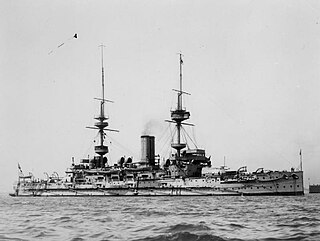
The third HMS Illustrious of the British Royal Navy was a Majestic-class pre-dreadnought battleship. The ship was built at the Chatham Dockyard; her keel was laid down in March 1895, her completed hull was launched in September 1896, and she was commissioned into the fleet in April 1898. She was armed with a main battery of four 12-inch (305 mm) guns and a secondary battery of twelve 6-inch (152 mm) guns. The ship had a top speed of 16 knots.
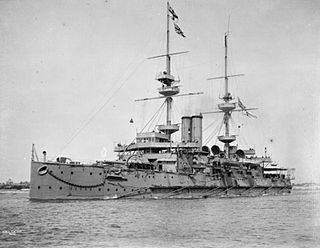
HMS Caesar was a Majestic-class pre-dreadnought battleship of the Royal Navy, named after the Roman military and political leader Julius Caesar. The ship was built at the Portsmouth Dockyard, starting with her keel laying in March 1895. She was launched in September 1896 and was commissioned into the fleet in January 1898. She was armed with a main battery of four 12-inch (305 mm) guns and a secondary battery of twelve 6-inch (152 mm) guns. The ship had a top speed of 16 knots.

HMS Goliath was a pre-dreadnought battleship of the British Royal Navy and a member of the Canopus class. Intended for service in Asia, Goliath and her sister ships were smaller and faster than the preceding Majestic-class battleships, but retained the same battery of four 12-inch (305 mm) guns. She also carried thinner armour, but incorporated new Krupp steel, which was more effective than the Harvey armour used in the Majestics. Goliath was laid down in January 1897, launched in March 1898, and commissioned into the fleet in March 1900.

HMS Albemarle was a pre-dreadnought Duncan-class battleship of the Royal Navy, named after George Monck, 1st Duke of Albemarle. Built to counter a group of fast Russian battleships, Albemarle and her sister ships were capable of steaming at 19 knots, making them the fastest battleships in the world. The Duncan-class battleships were armed with a main battery of four 12-inch (305 mm) guns and they were broadly similar to the London-class battleships, though of a slightly reduced displacement and thinner armour layout. As such, they reflected a development of the lighter second-class ships of the Canopus-class battleship. Albemarle was built between her keel laying in January 1900 and her completion in November 1903.

HMS Magnificent was one of the nine Majestic-class pre-dreadnought battleships of the Royal Navy. She entered service in late 1895 with the Channel Fleet, remaining with the fleet through its subsequent reorganisation into the Atlantic Fleet. In 1905, an explosion caused the deaths of 18 men but she remained in service until 1906, after which she underwent a refit. She served with the Home Fleet for most of her pre-war service.

HMS Africa was a pre-dreadnought battleship of the Royal Navy, and the penultimate ship of the King Edward VII class. The ship was built by Chatham Dockyard between 1904 and 1906. Armed with a battery of four 12-inch (305 mm) and four 9.2 in (234 mm) guns, she and her sister ships marked a significant advance in offensive power compared to earlier British battleship designs that did not carry the 9.2 in guns. Like all ships of the class, she was named after an important part of the British Empire, namely Africa.
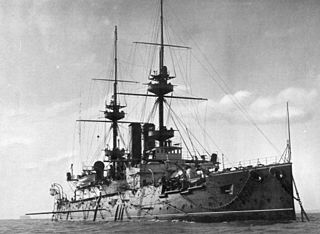
HMS Jupiter was a Majestic-class pre-dreadnought battleship of the Royal Navy. Commissioned in 1897, she was assigned to the Channel Fleet until 1905. After a refit, she was temporarily put in reserve before returning to service with the Channel Fleet in September 1905. In 1908 and rendered obsolete by the emergence of the dreadnought type of battleships, she once again returned to the reserve, this time with the Home Fleet. After another refit, she had a spell as a gunnery training ship in 1912.
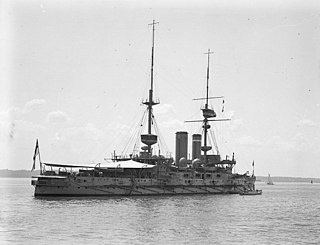
HMS Implacable was a Formidable-class battleship of the British Royal Navy, the second ship of the name. The Formidable-class ships were developments of earlier British battleships, featuring the same battery of four 12-inch (305 mm) guns—albeit more powerful 40-calibre versions—and top speed of 19 knots of the preceding Canopus class, while adopting heavier armour protection. The ship was laid down in July 1898, was launched in March 1899, and was completed in July 1901. Commissioned in September 1901, she was assigned to the Mediterranean Fleet and served with the fleet until 1908. After a refit, she transferred to the Channel Fleet, then onto the Atlantic Fleet in May 1909. By now rendered obsolete by the emergence of the dreadnought class ships, she was assigned to the 5th Battle Squadron and attached to the Home Fleet in 1912.

HMS Commonwealth was a King Edward VII-class battleship of the British Royal Navy. Like all ships of the class she was named after an important part of the British Empire, namely the Commonwealth of Australia. Armed with a battery of four 12-inch (305 mm) and four 9.2 in (234 mm) guns, she and her sister ships marked a significant advance in offensive power compared to earlier British battleship designs that did not carry the 9.2 in guns. Commonwealth was built at the Fairfield Shipbuilding and Engineering Company, and was laid down in June 1902, launched in May 1903, and completed in March 1905.

HMS Formidable, the third of four ships of that name to serve in the Royal Navy, was the lead ship of her class of pre-dreadnought battleships. The ship was laid down in March 1898, was launched in November that year, and was completed in September 1901. Formidable served initially with the Mediterranean Fleet, transferring to the Channel Fleet in 1908. In 1912, she was assigned to the 5th Battle Squadron, which was stationed at Nore.

HMS London was the lead ship of the London class of pre-dreadnought battleships built for the British Royal Navy. The Londons were near repeats of the preceding Formidable-class battleships, but with modified armour protection. The ship was laid down in December 1898, was launched in September 1899, and was completed in June 1902. Commissioned the same month, she served with the Mediterranean Fleet until early 1907. She was assigned to the Nore Division of the Home Fleet for nearly a year before transferring to the Channel Fleet. Rendered obsolete with the emergence of the new dreadnoughts in late 1906, she underwent an extensive refit in 1909, after which she served with the Atlantic Fleet. She was assigned to the Second Home Fleet in 1912 as part of the 5th Battle Squadron, and was temporarily fitted with a makeshift ramp for experiments with naval aircraft until 1913.

HMS Queen was a member of the London class of pre-dreadnought battleships built for the British Royal Navy. The Londons were near repeats of the preceding Formidable-class battleships, but with modified armour protection. Due to slight differences between Queen and HMS Prince of Wales and the other Londons, they are sometimes referred to as the Queen class. The ship's main battery consisted of four 12-inch (305-mm) guns, and she had top speed of 18 knots. The ship was laid down in March 1901, was launched in March 1902, and was completed in March 1904. After commissioning in April 1904, she served with the Mediterranean Fleet until 1906, when she returned to Britain before embarking on another stint with the Mediterranean Fleet later that year. Queen was transferred back to the United Kingdom in 1908 and thereafter served in the Atlantic Fleet, the Home Fleet, and finally the 5th Battle Squadron of the Second Fleet in 1914.

HMS Prince George was a Majestic-class pre-dreadnought battleship launched in 1895. She was named after the future George V of the United Kingdom and was the fourth and final ship to bear that name. Commissioned in 1896, she initially served with the Channel Fleet until 1904. She was involved in a collision with her sister ship, Hannibal, and the resulting damage meant that much of the latter part of 1903 was spent being repaired. After a refit in 1904, she was assigned to the Atlantic Fleet and then from 1907, she was part of the Home Fleet. In 1912, she was assigned to the 7th Battle Squadron.
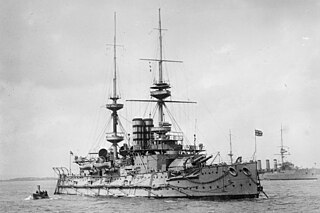
HMS Mars was a Royal Navy pre-dreadnought battleship of the Majestic class, the seventh member of a class of nine ships. The ship was laid down in the Laird Brothers shipyard in June 1894, she was launched in March 1896, and she was commissioned into the fleet in June 1897. She was armed with a main battery of four 12-inch (305 mm) guns and a secondary battery of twelve 6-inch (152 mm) guns. The ship had a top speed of 16 knots.

HMS Glory was a pre-dreadnought battleship of the British Royal Navy and a member of the Canopus class. Intended for service in Asia, Glory and her sister ships were smaller and faster than the preceding Majestic-class battleships, but retained the same battery of four 12-inch (305 mm) guns. She also carried thinner armour, but incorporated new Krupp steel, which was more effective than the Harvey armour used in the Majestics. Glory was laid down in December 1896, launched in March 1899, and commissioned into the fleet in November 1900.

HMS Duncan was the lead ship of the six-ship Duncan class of Royal Navy pre-dreadnought battleships. Built to counter a group of fast Russian battleships, Duncan and her sister ships were capable of steaming at 19 knots, making them the fastest battleships in the world. The Duncan-class battleships were armed with a main battery of four 12-inch (305 mm) guns and they were broadly similar to the London-class battleships, though of a slightly reduced displacement and thinner armour layout. As such, they reflected a development of the lighter second-class ships of the Canopus-class battleship. Duncan was built between her keel laying in July 1899 and her completion in October 1903.

HMS Exmouth was a Duncan-class pre-dreadnought battleship of the Royal Navy. Built to counter a group of fast Russian battleships, Exmouth and her sister ships were capable of steaming at 19 knots, making them the fastest battleships in the world. The Duncan-class battleships were armed with a main battery of four 12-inch (305 mm) guns and they were broadly similar to the London-class battleships, though of a slightly reduced displacement and thinner armour layout. As such, they reflected a development of the lighter second-class ships of the Canopus-class battleship. Exmouth was laid down by Laird Brothers at Birkenhead in August 1899, launched in August 1901, and completed in May 1903.

The French cruiser Pothuau was an armoured cruiser built for the French Navy in the 1890s. She spent most of her active career in the Mediterranean before becoming a gunnery training ship in 1906. The ship participated in the Kamerun campaign early in World War I before she was transferred to the Red Sea and the Indian Ocean in 1916 where she patrolled and escorted convoys. Pothuau fruitlessly searched the Indian Ocean for the German commerce raider Wolf in mid-1917. The ship resumed her previous role after the war until she was decommissioned in 1926 and sold for scrap three years later.
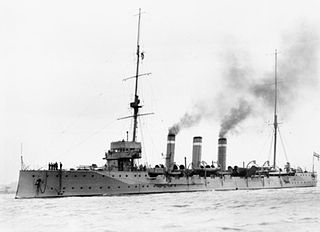
HMS Topaze was a Topaze-class protected or third-class cruiser which served in the Royal Navy during the First World War. The vessel was the lead ship of the class, also known as the Gem class, which had a more powerful armament and were faster than preceding protected cruisers. Launched on 23 June 1904, Topaze joined the Channel Fleet and often acted as a flotilla leader for the destroyers of the Navy. At the beginning of the First World War, the cruiser operated with the Fifth Battle Squadron, but was transferred to the Mediterranean Fleet in 1915. There, the cruiser operated with ships of the Italian Regia Marina to enforce the blockade on Albania and to escort ships carrying Italian troops and supplies across the Adriatic Sea. Topaze escorted shipping in the Indian Ocean and captured the Ottoman Army garrison on the island of Kamaran in 1917, but returned to the Mediterranean before the end of the year. After the Armistice in 1918, the cruiser returned to the United Kingdom and was decommissioned on 7 October 1919.




















